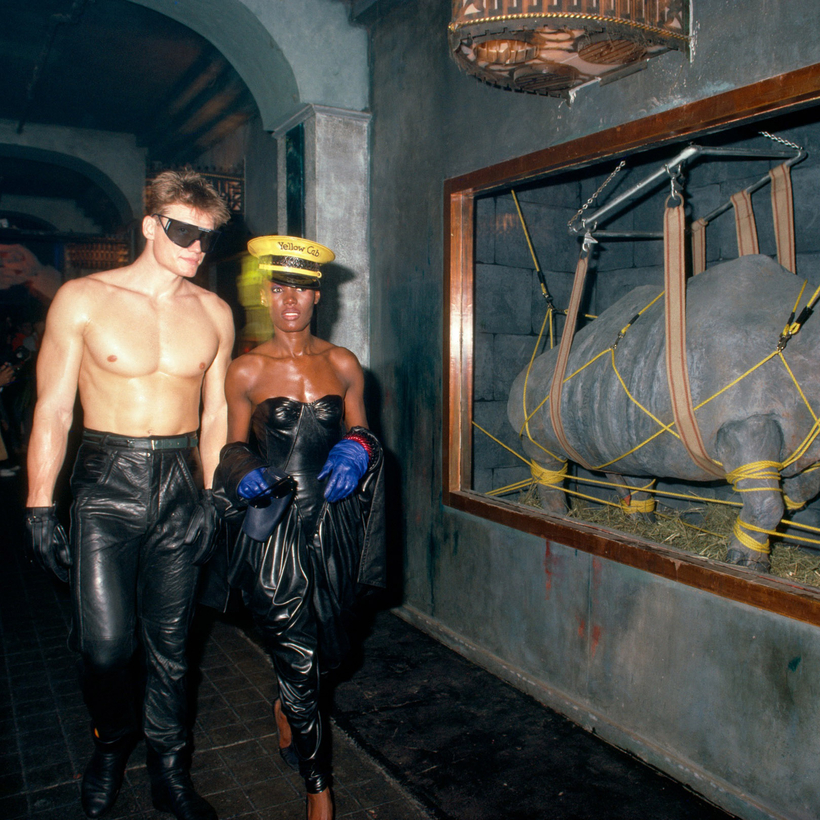For those who like to peregrinate without actually going anywhere, virtual reality is just the ticket, the next best thing to astral projection (something I’m dying to try). With a proper V.R. headset, 3D time travel and exotic exploration have never been more available, enabling psychonauts to tune in, turn on, and trip out.
Sure, you may look like a bug-eyed mutant to the snoopy neighbors as you weave your head this way and that, but what care you for the opinion of surface dwellers? You are off on inner voyages that can transport visitors to the surface of Mars, the rusty intestines of the Titanic, the sacred chambers of an Egyptian tomb, or the drafty recesses of Count Dracula’s castle.
All very enticing expeditions, but if I were commissioned to create and curate a V.R. experience closer to dear old home, my dream project would be a guided tour of downtown Manhattan’s legendary nightlife haunts now lost to time, myth, and gentrification. An experiment in psychogeography, it would provide a nostalgia binge for those of us who were there and allow millennials and Gen Z–ers to get a glimpse of what life was like in ancient Babylon.

Let’s kick off the night crawl at CBGB, on the Bowery, the holy manger of punk. Today, 315 Bowery is the site of a John Varvatos boutique, and the Bowery itself is no longer a dangerous, derelict stretch of broken bottles and battered souls, just another open-air mall of hip affluence. With a cinematic wipe, the gloss of the present dissolves, and it is the sweaty summer of 1975. Inside we go.
An avatar of Roberta Bayley, CBGB’s door person and ace photographer of the scene, takes our humble dollars for admission. Ensconced in a chair near the phone booth is owner Hilly Kristal, bearded and wearing his usual lumberjack plaid. Behind the bar is Merv, the genial, T.L.S.-subscribing bartender and occasional bouncer. It’s dark inside, loud, submarine-clamorous.
Who’s performing onstage? Use the control pedals to take your pick. Blondie bopping away. Patti Smith incantating. The Cramps staggering through the comic slapstick of “Sunglasses After Dark.” Or perhaps the Ramones, treating us to the melodic refrains of “I Wanna Be Sedated.”

No pilgrimage is complete without a visit to the CBGB bathroom. (Shrieks of horror.) Steel yourself. Vintage photographs, no matter how vivid, are unable to do justice to the stark depravity of the CBGB toilet resting on a raised platform, like a satanic throne. And yet, if you can stifle a gag reflex, there is a dense splendor perfect for V.R. examination. The graffiti-sprayed walls give that grotty grotto a grandeur that suggests an ongoing assault of action painting. Gaze in rapt awe, for it is a landmark of the age.
A magical cab ride whisks us to 77 White Street, home of the Mudd Club, the after-midnight hot spot named after the doctor who treated President Lincoln’s assassin, John Wilkes Booth, that opened in autumn 1978. Although the Mudd Club featured live performances (its inaugural band was the B-52’s), it was more of an art scene and buzz factor for the young, gifted, and dissolute—aspiring hustlers of every persuasion.
Jean-Michel Basquiat and Keith Haring were practically artists in residence there, and the fourth floor featured an alterna–art gallery curated by Haring. Once word caught on, Mudd became a celebrity nook for the celestial likes of David Bowie, John Waters, Madonna, and, hallowed be his name, Andy Warhol (who was everywhere and nowhere, like the Holy Spirit).

On our V.R. 3D tour, you will not only be able to float through the facilities but have your choice of attending two special Mudd Club events in 1979, Joan Crawford’s Mother’s Day Celebration (“No wire hangers,” admonished the original invitations) and the Dead Rock Stars Rock and Roll Funeral Ball, memorializing, among others, Elvis Presley, Jimi Hendrix, Janis Joplin, and that spindly, messed-up kid Sid Vicious.

Some V.R. tours make it possible to submerge oneself into majestic, vaulted caves and watch the stalactites drip. On this tour our portal into the enveloping dark takes us to Tunnel, a multi-chambered club way off at 220 12th Avenue—any farther west and you’d fall into the Hudson—converted from a warehouse railroad terminal that possessed a unique post-industrial vibe with a pagan zest (unisex bathrooms with a party bustle, S&M dungeons, go-go cages). It pulsated from 1986 to 2001, its closing another victim of Mayor Rudolph Giuliani’s “quality of life” campaign, which killed off so much nightlife.
Float with us past the row of urinals and toilets at the entrance and immerse yourself in some of Tunnel’s other notorious and intoxicating installations, painstakingly reconstructed for our ocular enjoyment, such as “the cabin in the woods,” with stuffed deer springing through the trees; the mental asylum (Marat/Sade for the MTV generation); and the Day-Glo, biomorphic, cartoonish extravaganza that is Kenny Scharf’s Cosmic Cavern. Don’t be surprised if you see a hologram of Patrick Bateman from American Psycho hugging a wall—this was one of his hangouts.

So many other stops we could make on this treasure hunt.
Limelight, at Sixth Avenue and 20th Street, a former Episcopal church converted into a dance-club playhouse with a sudsy Shampoo Room, cascades of glitter and confetti, and white powder by the snortful. The club would go through many permutations, closings, and reopenings from the 1990s on, but it was the murder and dismemberment of the drug dealer and Limelight regular Angel Melendez in 1996 that cemented the club’s notoriety. To atone for its sins, the site of the club is now a gym—Limelight Fitness.
Reno Sweeney, on West 13th Street, the cabaret that opened in 1972 and served as a showcase for Barbara Cook, Diane Keaton, Peter Allen, and “Little Edie” Beale from Grey Gardens.
But for a truly grand finale, only Area will suffice. A mammoth space at 157 Hudson Street, it originally housed the stables of American Express, and it was the subject of a totemic illustrated book published by Abrams in 2013. Unlike many of downtown’s night haunts, Area didn’t slowly acquire a rep but achieved immediate liftoff. On its opening night, in 1983, Andy Warhol was nearly squashed like a white mouse by the surging hordes trying to cram in.
He was undeterred. The next night, Warhol returned with Bianca Jagger, Ryan O’Neal, and Farrah Fawcett: a celebrity christening, the royal nod that Area was now Studio 54 South. (The original Studio 54, which reigned as the disco capital of Western civilization in the late 1970s, had gone into eclipse, creating flotillas of celebrity refugees looking for somewhere new to dock.)

The club surpassed its early promise as a pleasure dome: the most pandemonious, with beautiful bodies engaging in all variety of cosplay contortion (new thresholds, new anatomies!), and the most aesthetically bold and elaborate. Its invitations were witty and collectible—a blue pill for the opening, a black handkerchief for Halloween—and the ambitious theme projects boasted the outré theatricality of amusement parks on acid.

Be sure your V.R. headset is securely fastened as we venture through Suburbia, with its giant Trix-rabbit cereal box; Gas Station, reminiscent of an abandoned Twilight Zone set; and the tribute to director Federico Fellini, where a Satyricon food feast is in progress. Those undulating fashion models beckoning you to join them may be vampires, so beware.
The tour concludes with exiting the club and wobblily stepping out into the dawn, Lower Manhattan rebirthing itself before your bleary eyes.
To hear James Wolcott reveal more about his story, listen to him on AIR MAIL’s Morning Meeting podcast
James Wolcott is a Columnist for AIR MAIL. He is the author of several books, including the memoir Lucking Out: My Life Getting Down and Semi-Dirty in the Seventies and Critical Mass, a collection of his essays and reviews


